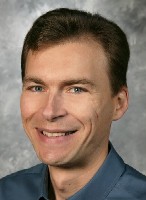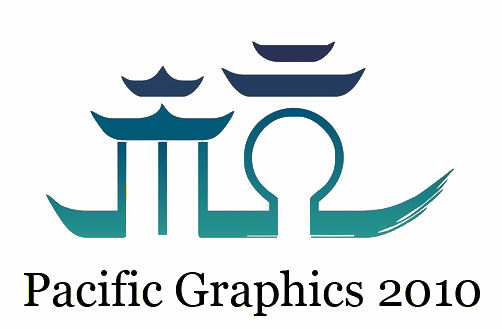Keynote Speaker 1
| |
|
|
 |
|
Hugues Hoppe
Principal researcher & Manager, Computer Graphics Group of Microsoft Research
Editor-in-chief, ACM Transactions on Graphics
|
| |
|
| |
|
| Title: Processing Large-Scale Imagery |
|
|
Abstract: |
In this talk, I present recent research on processing large images. Motivating examples include gigapixel panoramas from consumer cameras, terapixel sky surveys from telescope photographs, and even larger satellite and aerial views. Such data is commonly browsed using Web applications like HD View, WorldWide Telescope, and Google Maps. However, assembling such image content is challenging. While some image processing techniques are embarrassingly parallel, important operations like image stitching and tone mapping are best expressed using image gradients rather than local values, and therefore lead to globally defined sparse linear systems. We explore efficient solutions to such systems. Contributions include a streaming multigrid approach to reduce memory and I/O bottlenecks, use of second-order finite elements for faster convergence, extension to spherical domains, and distributed computation. Prior work on image fusion and stitching has focused on creating seamless imagery at one scale. However, multiscale imagery often merges several sources with differing appearance, for instance satellite and aerial photography. Zooming may then reveal jarring transitions. We present a scheme that optimizes both spatial and scale continuity to create a visually smooth mipmap pyramid, and thereby obtain a continuous zooming experience from space to ground level.
These projects are joint work with Michael Kazhdan (Johns Hopkins University) and Charles Han (Columbia University). More information can be found at http://research.microsoft.com/~hoppe/ . |
| |
|
Bio: |
|
Hugues Hoppe is a principal researcher and manager of the Computer Graphics Group at Microsoft Research. His primary interests lie in the multiresolution representation, parameterization, and synthesis of both geometry and images. He received the 2004 ACM SIGGRAPH Computer Graphics Achievement Award for pioneering work on surface reconstruction, progressive meshes, geometry texturing, and geometry images. His publications include 30 SIGGRAPH/TOG papers, and he is currently editor-in-chief of ACM Transactions on Graphics. He obtained a BS summa cum laude in electrical engineering in 1989 and a PhD in computer science in 1994 from the University of Washington. |
Keynote Speaker 2
| |
|
|
 |
|
Niloy J. Mitra
Vision and Graphics Group
Dept. of Computer Science and Engg
Indian Institute of Technology
|
| |
|
| |
|
| Title: Analysis and Manipulation of 3D Geometry |
|
|
Abstract: |
Easy acquisition techniques and commonly available modeling tools have resulted in large collections of 3D polygonal models, digitally acquired from physical objects or modeled from scratch. Such low-level polygonal representations, however, do not make specific the characteristics and invariants of the underlying objects.
In the first part of the talk, I will present different shape analysis strategies, specially for detecting object symmetry, i.e., invariance under the action of certain transformations. I will describe a simple algorithm for detecting partial and approximate symmetries in shape, and then build on the basic scheme to enable detection of more general symmetry relations. This in turn leads to more powerful shape representations that are easier and intuitive to handle.
In the second part of the talk, I will describe how such high-level shape invariants, extracted in the analysis phase, can be readily used in a range of applications including shape completion, smart geometry editing, motion visualization, shape abstraction, which are otherwise challenging to perform. webpage: http://graphics.stanford.edu/~niloy/research/index.html |
| |
|
Bio: |
|
Niloy J. Mitra is an assistant professor at the CS department at IIT Delhi and a visiting professor at TU Vienna. Previously he was an assistant professor at KAUST, and before that a postdoctoral scholar at TU Vienna. He received his Ph.D. degree in 2006 and master in 2002 from the Electrical Engineering department at Stanford University, and his Bachelor degree from IIT in 1999. His research interests include shape analysis, geometric modeling, shape perception, recreational art, and computer graphics. Niloy also loves reading, rock climbing, hiking and cooking. |
Keynote Speaker 3
| |
|
| |
|
Title: Advances and Open Problems in Material Appearance Modeling |
|
|
| |
|
Abstract: |
|
The past ten years have seen significant advances in modeling material appearance. In this talk I will review the advances in this area with particular emphasis on acquiring data for material appearance, modeling appearance change over time, and modeling specialized materials. Despite these advances, in many ways material modeling lags behind geometric modeling. I will outline areas where more research is needed including authoring material appearance models, search techniques for materials, combining appearance and geometric properties of materials, and application of material modeling in areas such as manufacturing, cultural heritage and evolutionary biology.
|
|
| |
|
Bio: |
|
Holly Rushmeier received the BS, MS and PhD degrees in Mechanical Engineering from Cornell University in 1977, 1986 and 1988 respectively. Between receiving the BS and returning to graduate school in 1983 she worked as an engineer at the Boeing Commercial Airplane Company and at Washington Natural Gas Company (now a part of Puget Sound Energy). In 1988 she joined the Mechanical Engineering faculty at Georgia Tech. While there she conducted sponsored research in the area of computer graphics image synthesis and taught classes heat transfer and numerical methods at both the undergraduate and graduate levels. At the end of 1991 Dr. Rushmeier joined the computing and mathematics staff of the National Institute of Standards and Technology, focusing on scientific data visualization.
From 1996 to early 2004 Dr. Rushmeier was a research staff member at the IBM T.J. Watson Research Center. At IBM she worked on a variety of data visualization problems in applications ranging from engineering to finance. She also worked in the area of acquisition of data required for generating realistic computer graphics models, including a project to create a digital model of Michelangelo's Florence Pieta, and the development of a scanning system to capture shape and appearance data for presenting Egyptian cultural artifacts on the World Wide Web.
Dr. Rushmeier was Editor-in-Chief of ACM Transactions on Graphics from 1996-99. She has also served on the editorial board of IEEE Transactions on Visualization and Computer Graphics. She is currently on the editorial boards of IEEE Computer Graphics and Applications and Computer Graphics Forum. In 1996 she served as the papers chair for the ACM SIGGRAPH conference, in 1998 as the papers co-chair for the IEEE Visualization conference and in 2000 as the papers co-chair for the Eurographics Rendering Workshop. She has also served in numerous program committees including multiple years on the committees for SIGGRAPH, IEEE Visualization, Eurographics, Eurographics Rendering Workshop, and Graphics Interface. |

|
|
| |
PG2010 ⇒ Travel & Accomodation |
|
| |
|
|
| |
News |
|
| |
9/25/2009 |
|
pg2010 web page is open! |
|
| |
|
|
|
|
| |
6/9/2010 |
|
Invited talks information has been posted. |
|
| |
|
|
|
|
| |
8/4/2010 |
|
Program information is available. |
|
| |
|
|
|
|